Text
Introduction
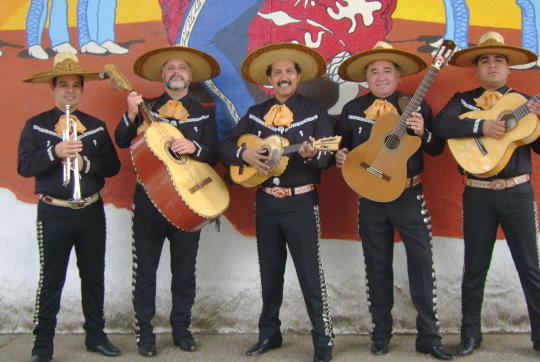
(Above image: Mexico Lindo Mariachi, 2007, http://mexicolindomariachi.com/.)
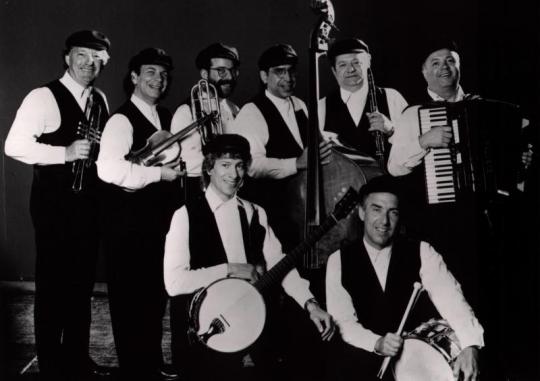
(Above images: In Concert at the Santa Monica Civic Auditorium, http://www.klezmerlosangeles.com/.)
In my music links investigation, I have chosen to find links between two songs, one from mariachi and the other from klezmer. Mariachi is a genre that originates from Mexico and gained recognition during the 19th century.(1) Klezmer is a distinctively Jewish genre that began in Eastern Europe but spread to the United States with Jewish and Eastern European immigrants in the 19th century.(2) From these genres, I have chosen two instrumental songs. The mariachi song is “Las Abejas,” and the klezmer song is “Der Heyser Bulgar.” At first, it seems as though these two genres would have nothing in common, coming from opposite sides of the world. Upon further investigation, however, there are many links within these two songs that tie the two genres together. For my music links investigation, I will investigate the texture, the tempo, the rhythm, and syncopation. The differences that will highlight these similarities are key and meter. I believe that the two genres’ similar purposes for dance and celebration will help to find elements within the music that will link the two together.
1. “Introduction to Mariachi Music,” TeacherVision, accessed October 27, 2016, https://www.teachervision.com/mexico/music/6757.html.
2. Carl Dimow, “A Brief History of Klezmer Music,” Casco Bay Tummlers, accessed December 10, 2016, http://cascobaytummlers.com/history.html.
0 notes
Text
Song 1 - “Las Abejas”
youtube
This song is “Las Abejas,” and it comes from the genre of mariachi.(3) This song was performed in 1997 by the group Mariachi Los Toritos, a Mexican mariachi group.(4) This song’s Spanish name translates to “The Bees.” Within this genre, “Las Abejas” is a son jalisciense, a popular type of song from Jalisco, Mexico, the birthplace of mariachi.(5) This type of song combines Mexican folk, Spanish Baroque, and African elements.(6) It can be categorized as a son jalisciense because it is a song in a major key (here, the key of G Major), in 12/8 time, and features the guitar, vihuela, violin, and guitarron.(7)
3. Mariachi Los Toritos, “Las Abejas” in Sones Jalicienses, IM Music Group, 1997, accessed October 27, 2016. https://youtu.be/_7puDuchJeM.
4. Mariachi Los Toritos, “Las Abejas.”
5. John Clark, “History of mariachi,” El Mariachi, accessed February 18, 2017, http://www.laits.utexas.edu /jaime/cwp4/ioc/mariachi.html.
6. “History of the Mariachi,” Puro Mariachi, accessed December 10, 2016, http://www.mariachi.org/history. html.
7. Ibid.
0 notes
Text
Song 2 - “Der Heyser Bulgar”
youtube
This song is “Der Heyser Bulgar,” and it comes from the genre of klezmer.(8) This song was first recorded in 1923 by Naftule Brandwein,(9) an influential clarinet klezmorim (klezmer musician) considered to be part of the first wave of Jewish immigrant musicians to America.(10) This rendition of the song was performed in 2008 by Itzahk Perlman, a world-renowned Israeli-American violinist.(11) This song’s name translates to “The Hot Bulgar.” A “hot bulgar” does not refer to a handsome Bulgarian, but rather to a lively Jewish-American klezmer dance, the bulgar, which gained popularity in the early 20th century.(12) The bulgar itself originates from Romania, rather than Bulgaria.(13) Since most klezmer songs come from oral tradition, these songs would not have titles like songs today, and would instead be named after their rhythm or song type, here named after the bulgar.(14)
8. Itzahk Perlman, “Der Heyser Bulgar,” in Perlman plays Klezmer, Warner Classics, 2008, accessed October 27, 2016, https://www.youtube.com/watch?v=HzuFWgH8W2U.
9. Khasene Nigunim, Der Heyser Bulgar. Cedarhurst: Tara Publications Jewish Music, 1967, accessed October 27, 2016, http://www.espressomap.com/songs/Der%20Heyser%20Bulgar.pdf.
10. Dimow, “A Brief History of Klezmer Music.”
11. “Itzhak Perlman Biography,” Biography.com, accessed December 7, 2016, http://www.biography.com/ people/itzhak-perlman-9437933.
12. Mark S. Slobin, “Klezmer music,” Encyclopaedia Britannica, accessed December 7, 2016, https://www. britannica.com/art/klezmer-music.
13. Michael Borzykowski, “Klezmer Music in a Few Words,” Welcome to the (Swiss!) Klezmer Music Page, accessed February 20, 2017, http://borzykowski.users.ch/EnglMCKlezmer.htm.
14. Ibid.
0 notes
Text
Link 1 - Homophonic Textures
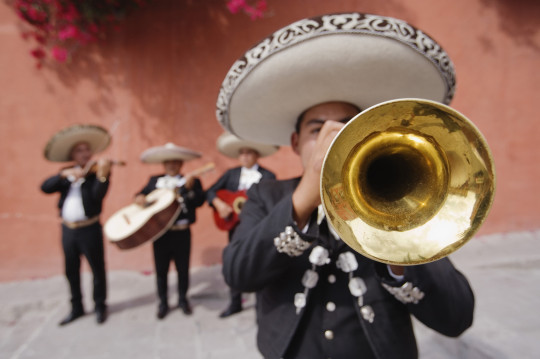
(Above image: Google Photos, http://www.sohogrand.com/category/music/.)
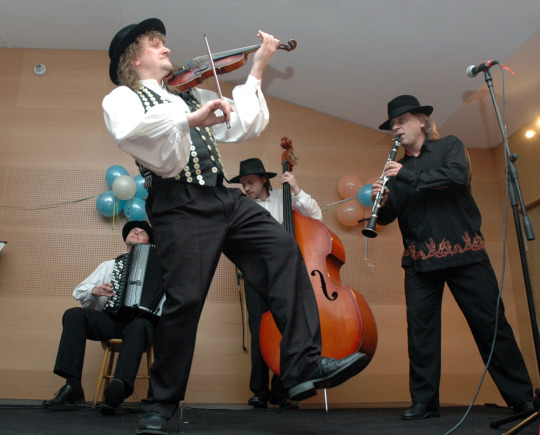
(Above image: Henryk Kotowski, Sastav Lubliner Klezmorim na svirci u Varšavi, 2009, https://hr.wikipedia.org/wiki/Klezmer#/media/File:Lubliner_klezmorim_march2009.jpg.)
The first link I have found is texture. Both songs are homophonic, meaning that there will be one lead voice carrying the melody, while other instruments serve as accompaniment to the main voice. Since these songs are homophonic, the different lines fall together to create points of harmony. However, a difference within this link is that “Las Abejas” has a thin homophonic texture, while “Der Heyser Bulgar” has a thick homophonic texture. In “Las Abejas,” some example of the song’s thin, homophonic texture would be at 0:17 to 0:33, 0:42 to 1:07, and 1:32 to 1:41. Here, there are only two voices at a time, either trumpet or violins as well as guitarron and guitars playing the supporting rhythm. In “Der Heyser Bulgar,” the examples of the thick, homophonic texture are at 0:21 to 0:40, 0:51 to 1:03, 1:52 to 2:09, 2:22 to 2:33, and 3:23 to 3:41. At these segments, the solo violin is still the main voice, but all other instruments play slightly different lines of melody as well. The accompanying violins and trumpets support the main voice and also play short interjections of melodic phrases, such as the trumpet at 0:30 to 0:31 and 0:55 to 0:58. At 1:52 to 1:58 and 2:22 and 2:33, the trumpet also plays a separate melody from the solo violin but does not compete for lead voice.
0 notes
Text
Link 2 - Fast Tempos
http://www.danporges.com/jewish-wedding-men-dance-separately-and-klezmer-playng-accordion
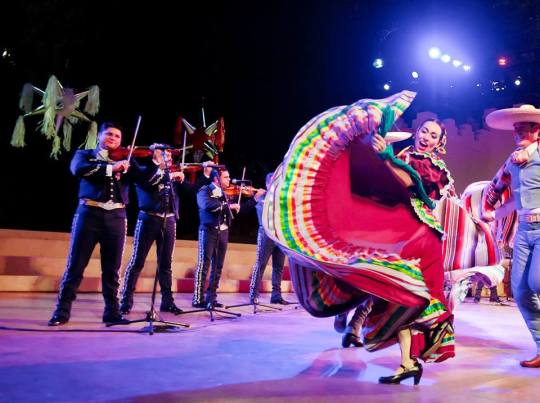
(Above image: DANCING WITH MARIACHI LOS CAMPEROS AT THE FORD AMPHITHEATER, http://folkloricocompany.com/blog/2016/2/10/a-folklrico-dancers-guide-to-dancing-with-live-music.)
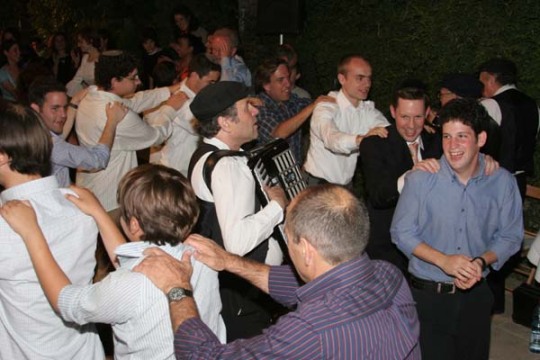
(Above image: Dan Porges, Jewish wedding, men dance separately and a klezmer playng the accordion, 2005, http://www.danporges.com/jewish-wedding-men-dance-separately-and-klezmer-playng-accordion.)
The two songs also share a fast tempo and are within about 10 BPM from each other. The BPM of this rendition of “Der Heyser Bulgar” is 160 BPM, which would be allegro. The BPM of “Las Abejas” here is 170 BPM, which would be presto. Since both of these songs are known to be dance or celebration (especially weddings) songs,(15)(16) tempo is an important link between the two songs. Dance songs in any musical culture typically share fast tempos and regular rhythms to facilitate their designated dance styles. Lively, fast-paced mariachi songs are considered dance songs because they are typically played at festivals and weddings, where dancing has historically taken place.(17) Klezmer songs were a key part of Jewish celebrations. Even Jewish wedding traditions would require a certain dance to complete the ritual, and thus music would be needed.(18) As the name states, this song is a bulgar, which was also a specific Jewish dance. The dance itself would have been a fast-paced, circular step dance, which would be suited by a fast tempo such as this.(19)
15. “Introduction to Mariachi Music.”
16. Slobin, “Klezmer music.”
17. Clark, “Introduction of mariachi.”
18. Michael Borzykowski, “Yiddish, Klezmer, Ashkenazic or 'shtetl' dances,” Welcome to the (Swiss!) Klezmer Music Page, accessed February 20, 2017, http://borzykowski.users.ch/EnglYidDance.htm #bulgardanse.
19. Ibid.
0 notes
Text
Link 3 - Ostinato

(Above image: Google Images, https://mariachiemperador.blogspot.com/2015/12/origenes-del-mariachi.html.)
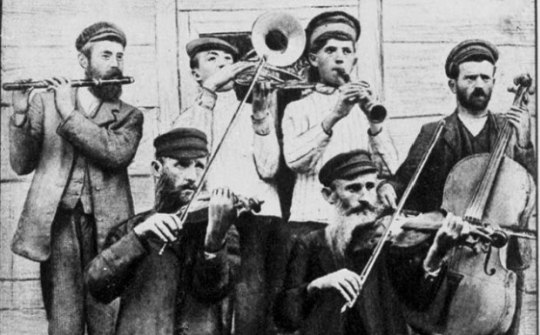
(Above image: Google Images, http://ujew.com.ua/zajt-gezunt-i-dobranich-ili-podpol-naya-muzyka-shtetlov.)
Another link present between both songs is the use of ostinato throughout both songs. However, another unique link within the ostinato is that the rhythm of the song is established on instruments which are traditionally not used for the rhythmic foundation of a song. This is because mariachi and klezmer typically do not feature traditional percussive instruments except in modern renditions. Historically, mariachi bands were known for being “wandering” bands after the Mexican revolution,(20) and many klezmer performers were immigrants or refugees escaping pogroms who needed to carry their own instruments as they traveled.(21) Traditional percussive instruments like the drum set are often only used in modern renditions and fusion with modern genres like jazz and rock.(22)(23)

(Above image: Google Images, http://nmidigital.com/klezmer-genero-musical-cargado-de-historia/.)
In “Las Abejas,” the ostinato is carried on the guitarron, playing steady, deep notes beneath the other instruments. It is far more usual to find the rhythm in a mariachi song carried in the strings section that on an actual percussive instrument, as shown in this song.(24) The guitarron sets up the following rhythm.

This ostinato can be heard clearly in the opening from the beginning to 0:16. The ostinato can be heard continually through the whole song, but can be distinguished during the violins’ solo from 0:17 to 0:32, as only three instruments play here (the violins, the guitarron, and a soft supporting guitar). The violins also have longer notes than the guitarron’s, so the shorter rhythmic pattern of the ostinato can be distinguished.
In “Der Heyser Bulgar,” the ostinato is on the tambourine and supporting violins. It can be heard in the opening from 0:03 to 0:20. Here, the violin begins a solo in an octave higher than the other violins, distinguishing the lower voices beneath the solo violin and allowing the ostinato of the tambourine and supporting violins to be heard. The tambourine sets up the following rhythm.

The ostinato is played throughout the whole song, but can be easily heard again from 0:40 to 0:51. At this point, some of the supporting violins, instead of playing with long bowing, play bouncier staccato notes with shorter strokes, further distinguishing the ostinato. The ostinato ends at 3:41 as all instruments begin playing the same rhythm for the cadence leading into the fermata to finish the song.
20. Camille Collins, “What is the mariachi?” Mexconnect, accessed December 10, 2016, http://www. mexconnect.com/articles/1875-what-is-the-mariachi.
21. Slobin, “Klezmer music.”
22. Wilhelm Schnotz, “What Instruments Are Played In Klezmer Music?” eHow, accessed December 7, 2016, http://www.ehow.com/list_6734830_instruments-played-klezmer-music_.html.
23. Randy Hargis, “Mariachi Percussion?” West Music Blog, accessed December 10, 2016, http://www. westmusic.com/blogs/mariachi-percussion.aspx.
24. Ibid.
0 notes
Text
Link 4 - Syncopation

(Above image: Scott Poe, The mariachi band Viva Jalisco, performed during Diversity Day Sept. 26, 2014, at Little Rock Air Force Base, Ark. Diversity Day unites all cultures and encourages all Airmen to embrace each other’s differences, 2014, http://www.littlerock.af.mil/News/Article-Display/Article/764560/diversity-day-2014/.)
Another important link is that both songs feature different types of syncopation, meaning that beats that are typically unstressed are accented. In “Las Abejas,” a song in 12/8 time, the accent is on 2 and 5 (123 456). This type of triple meter is common for sones jaliscienses.(25) This song also features a common son guitar rhythm known as a caballito. With this type of rhythm, the guitar is strummed in threes with an emphasis on the second strum.(26) One can clearly hear accent on 2 with the heavy second strum, emphasizing the syncopation.

(Above image: Google Images, http://www.webgiare.info/2017jimage-jewish-wedding-dance.awp.)
In “Der Heyser Bulgar,” there is a very unique rhythm present. This song is in 8/8, with an accent on 1 (123 123 12). Unlike other songs in duple meter which emphasize the second beat, this song accents the first beat. This is common among bulgars, as dancing the bulgar required a particular rhythm.(27) Bulgars were unique within klezmer specifically for their syncopated, lively rhythm.(28)
25. George Torres, Encyclopedia of Latin American Popular Music (Santa Barbara: ABC-CLIO, 2013), https://books.google.com/books?id=MX5BXxjwV9cC&dq=son+jalisciense&source=gbs_navlinks_s.
26. Ibid.
27. “Dance and Dance Rhythms,” Klezmer - The American Revival, accessed December 10, 2016, http:// klezmerrevival.weebly.com/dances-and-dance-rhythms.html.
28. Slobin, “Klezmer music.”
0 notes
Text
Link 5 - Cadences
The final link between these two songs is their similarity in cadences. Both songs feature authentic cadences at the end of each section. For “Las Abejas,” the authentic cadences are in the key of G Major and go from the dominant chord (D) to the tonic chord (G). For “Der Heyser Bulgar,” the authentic cadences in the ahava raba mode starting at D and go from the dominant chord (A) to the tonic chord (D). The following is a chart of notable authentic cadences within both songs.
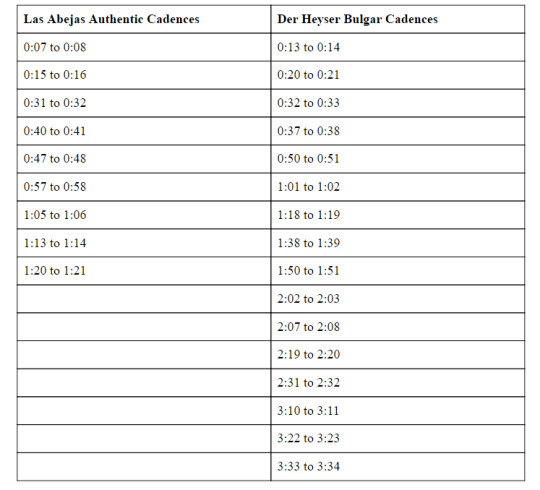
“Las Abejas” song also ends on a clear authentic cadence at 1:47 to 1:49. “Der Heyser Bulgar” also ends on an authentic cadence at 3:40 to 3:47 with a long fermata.
0 notes
Text
Difference 1 - Key
Just as the songs have many links tying them together, there are also differences that show the uniqueness to their cultures. One important difference between the two is the keys of the songs. Upon listening, one can tell that “Las Abejas” is clearly in major key, which is an important characteristic of sones jalisciense.(29) The key of this song is in the key of G Major. Since “Der Heyser Bulgar” is a klezmer song, it comes from a musical tradition that has its own set of unique modes. Klezmer instead uses three important modes: the ahava raba, the natural minor mode, and the misheberakh mode.(30) “Der Heyser Bulgar” is in the ahava raba scale (or Phrygian dominant scale) and begins in the key of D, which uses the following notes: D E♭ F# G A B♭ C.(31)
29. “History of the Mariachi.”
30. Michael Levy, “Klezmer Scales,” The Klezmer Fiddle, accessed February 20, 2017, https://sites.google. com/site/klezmerfiddle/what-is-klezmer-music-4/the-main-klezmer-scales-modes.
31. Ibid.
0 notes
Text
Difference 2 - Meter
Lastly, a distinguishable element between the two songs is their meters. “Las Abejas” is in 12/8 time, stemming from the fact that the melody itself is played quickly in triple meter, but can also be counted within a slower duple meter. This meter is very common among mariachi songs, especially sones jaliciences.(32) “Der Heyser Bulgar,” on the other hand, is in 8/8 time. This is two compound beats and one simple beat.(33)

32. George Torres, Encyclopedia of Latin American Popular Music.
33. “Odd Meter.” Musictheory.net, accessed March 8, 2017, http://www.musictheory.net/lessons/16.
0 notes
Text
Closing
In conclusion, by their nature of being songs in a genre known for its danceability and use in celebration, “Las Abejas” and “Der Heyser Bulgar” share many significant links. This shows not only the connection of the songs themselves, but the cultures they come from.
0 notes
Text
Bibliography
Borzykowski, Michael. “Klezmer Music in a Few Words.” Welcome to the (Swiss!) Klezmer Music Page. Accessed February 20, 2017. http://borzykowski.users.ch/EnglMCKlezmer.htm.
Borzykowski, Michael. “Yiddish, Klezmer, Ashkenazic or 'shtetl' dances.” Welcome to the (Swiss!) Klezmer Music Page. Accessed February 20, 2017. http://borzykowski.users.ch/EnglYidDance.htm#bulgardanse.
Clark, John. “History of mariachi.” El Mariachi. Accessed February 18, 2017. http://www.laits.utexas.edu/jaime/cwp4/ioc/mariachi.html.
Collins, Camille. “What is the mariachi?” Mexconnect. Accessed December 10, 2016. http://www.mexconnect.com/articles/1875-what-is-the-mariachi.
“Dance and Dance Rhythms.” Klezmer - The American Revival. Accessed December 10, 2016. http://klezmerrevival.weebly.com/dances-and-dance-rhythms.html.
Dimow, Carl. “A Brief History of Klezmer Music.” Casco Bay Tummlers. Accessed December 10, 2016. http://cascobaytummlers.com/history.html.
Hargis, Randy. “Mariachi Percussion?” West Music Blog. Accessed December 10, 2016. http://www.westmusic.com/blogs/mariachi-percussion.aspx.
“History of the Mariachi.” Puro Mariachi. Accessed December 10, 2016. http://www.mariachi.org/history.html.
“Introduction to Mariachi Music.” TeacherVision. Accessed October 27, 2016. https://www.teachervision.com/mexico/music/6757.html.
“Itzhak Perlman Biography.” Biography.com. Accessed December 7, 2016. http://www.biography.com/people/itzhak-perlman-9437933.
Levy, Michael. “Klezmer Scales.” The Klezmer Fiddle. Accessed February 20, 2017. https://sites.google.com/site/klezmerfiddle/what-is-klezmer-music-4/the-main-klezmer-scales-modes.
Mariachi Los Toritos. “Las Abejas” in Sones Jalicienses. IM Music Group, 1997. Accessed October 27, 2016. https://youtu.be/_7puDuchJeM.
Nigunim, Khasene. Der Heyser Bulgar. Cedarhurst: Tara Publications Jewish Music, 1967. http://www.espressomap.com/songs/Der%20Heyser%20Bulgar.pdf.
“Odd Meter.” Musictheory.net. Accessed March 8, 2017. http://www.musictheory.net/lessons/16.
Perlman, Itzak. “Der Heyser Bulgar” in Perlman plays Klezmer. Warner Classics, 2008. Accessed October 27, 2016. https://www.youtube.com/watch?v=HzuFWgH8W2U.
Slobin, Mark S. “Klezmer music.” Encyclopaedia Britannica. Accessed December 7, 2016. https://www.britannica.com/art/klezmer-music.
Schnotz, Wilhelm. “What Instruments Are Played In Klezmer Music?” eHow. Accessed December 7, 2016. http://www.ehow.com/list_6734830_instruments-played-klezmer-music_.html.
Torres, George. Encyclopedia of Latin American Popular Music. Santa Barbara: ABC-CLIO, 2013. https://books.google.com/books/id=MX5BXxjwV9cC&dq=son+jalisciense&source=gbs_navlinks_s.
0 notes